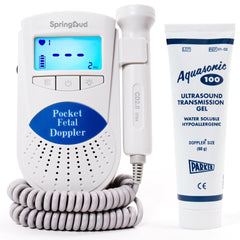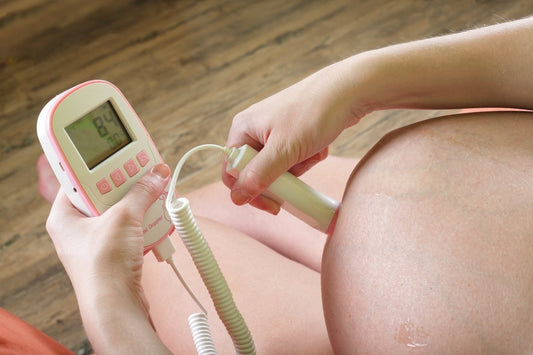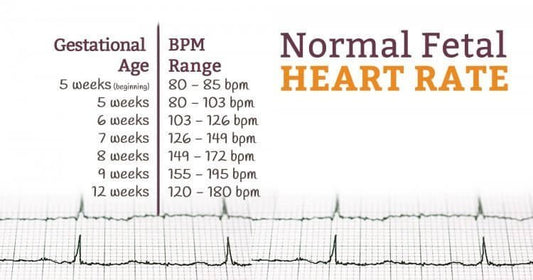
Expecting mothers have a long list of items they need to buy during and after the pregnancy. They need items like: a breast pump, pacifiers, belly bands, a pregnancy pillow, bottles, and an item that is often overlooked -- fetal doppler.
What is Fetal Doppler?
A fetal doppler is a heart monitor for prenatal babies. It detects the heart rate of the unborn child and determines if there are any issues. This helps concerned parents assure themselves that nothing without rushing to the hospital. Though the fetal doppler is relatively uncommon, they existed since the 1950s. They’ve primarily been used by doctors and midwives, but anyone can use them. They are great for the doctor’s office, as well as at home.
The Function of the Fetal Doppler
The fetal doppler uses the doppler effect-- the change in frequency in sound and light waves-- to simulate the baby’s heartbeat. This allows the parents and their doctor to heart the child’s heartbeat before birth. The primary function of this device to make sure the baby’s heartbeat is safe and healthy. This product is particularly beneficial for early pregnancies. If a baby has a healthy heartbeat at the beginning of the pregnancy, the parents are less likely to experience pregnancy loss. The doppler also acts as a device that helps check in on the baby when there is not enough time or money for multiple hospital visits. Otherwise, the fetal doppler is great for parents to hear their child’s heartbeat for the time, or as many times as they would like there after.
The fetal doppler is especially important for high-risk pregnancies. Parents can use this product to regularly check up on their unborn child. If the heartbeat seems irregular, they can rush to the doctor and get the situation fixed immediately.
Before using a fetal doppler, there are items and procedures one must take. To be completely and full prepared to use it, acquire these products:
-
Batteries: Many fetal dopplers require batteries to work. It would be so unfortunate to prepare to hear a child’s heartbeat, only to have that moment ruined by not having batteries. Some lucky parents will find that their fetal doppler may already include the batteries.
-
Headphones/speaker: If more than one person wants to hear the heartbeat, those using the fetal doppler should buy headphones to go with it. This makes the sound of the heartbeat more clear and pronounced.
-
Ultrasound Gel: Ultrasound gel’s primary purpose is to help connect the device to the womb. It eliminates air that would disrupt the sound of the heartbeat. Though using ultrasound isn’t a necessity for the fetal doppler, it increases the clarity of the sound and eliminates static noises.
-
A Quiet Place to Recline: Listening to a child’s heartbeat for the first time is a beautiful experience. It requires attention and focus. It may take awhile to actually hear the heartbeat, so a calm, quiet space is important to allow full attentiveness.
-
Towel: The ultrasound gel is sure to make a mess. Set up a towel or some sort of rag to clear the excess ultrasound gel before and after the fetal doppler screening.
-
Patience: Using a fetal doppler doesn’t always warrant a result. Be patient when listening to the heartbeat. If there is no sound, don’t worry about it. It’s hard to actually connect to the baby sometimes. Turn the device off and try again on another day.
Once these items are set up and ready for usage, it is time to begin using the fetal doppler.
How to Use Fetal Doppler
Using the fetal doppler is a simple enough task. Follow the instructions exactly as they are told, and soon enough everyone will be hearing the beautiful sound of an unborn baby’s heartbeat.

-
The mother should begin this process by lying completely flat on her back. She should lay on a flat, yet comfortable surface as she will be spending a lot of time here.
-
Add a glob of ultrasound gel to the stomach region. Use a large amount of this gel, as it will help clear up the sound of the heartbeat. This can be done by the mother, but it is preferred that another person do it so the mother can stay laying at her back.
-
Grab the fetal doppler and place it within the ultrasound gel. Once it is in a good location, turn the device on.
-
Starting at the pubic bone (located directly under the stomach) the person operating the fetal doppler should slowly slide it up the stomach to the belly button area. Guide the fetal doppler from one side of the belly to the other. Use the fetal heart position reference below to determine the best location to move the fetal doppler. This is dependent on how developed the fetus is.
-
Once the heartbeat is found, the fetal doppler should note a heartbeat of 120 beats a minute or higher. If the heartbeat is not found, do not fret. Turn off the device and try again in a few minutes. The key to this process is patience. It’s not always easy to find the baby’s heartbeat, but it is very rewarding when it happens.
-
Once this process is finished, use a towel to wipe the excess ultrasound good off of the stomach and turn off the device.

Knowledge to Know
-
An adult’s heart rate is much slower than a baby’s heart rate. That’s because babies need a more rapid heart rate to speed their growth and make up for heat loss within their environment. The average adult has a heart rate of 60 to 100 beats per minute.
-
The average fetal heart rate is 120-180 beats per minute. This should be noted when using the fetal doppler.
-
Fetal heartbeat cannot be detected before week 12 most of the time depending on factors, such as fetal position, mother’s weight and the shape of uterus. Therefore, we recommend to use the device at or after 12 weeks.
Notes:
Where to Hear the Heartbeat on the Belly:
The heartbeat can be found directly below the belly button. This is the most effective and common place to find a baby’s heartbeat.
Placement: Use the fetal doppler at the bottom of the abdomen-- as this is the most common place to find the heartbeat-- and work up the belly.
Movement: Move the fetal doppler from one side to the other in a slow motion. Move it side to side and then up the belly.
Gel Application: Place a generous amount of gel all over the stomach region to maximize the results of the fetal doppler.
Some Notice:
-
Recommended frequency of using the fetal heart rate monitor is 1 to 3 times per day. 1 to 2 minutes per time.
-
Be gentle with the device. It is harder to get a heartbeat reading when pressing the fetal doppler too roughly. Be careful and calm with the device. Treat it as if it’s actually touching the baby.
-
Use it earlier in the day. It is easier to find the heartbeat in the wee hours of the morning because the mother is less bloated and just waking up. Other great times for using the fetal doppler are after lunch and before bed. Check out some of suggested time periods to use the fetal doppler below.
-
Hold in pee. When the bladder is full, the baby is pushed forward in the womb which may make locating the heartbeat easier. Drink a large glass of water an hour or so before using the fetal doppler could be also helpful to maximize the likelihood of finding the heartbeat.
-
Clean the fetal doppler between uses. Any excess ultrasound gel that gets on the product will affect the sound each time it is used. Clean it frequently to eliminate this issue.
-
The fetal doppler should not be used in lieu of a doctor and regular appointments. It is a tool to help during the pregnancy; it is not a medical professional.
Doctor Knows Best
Before getting started with the fetal doppler, consult a doctor. They will walk expecting parents through the process of using the fetal doppler, and warn them of any hazards that may come with using it. They will also remind parents to continue to come to their regular appointments, as the fetal doppler does not know everything about the child and its health.
How to Read the Result
The fetal doppler has a screen that will show the baby’s heart rate per minute. The heart rate will likely be about 120 beats per minute, with some reaching 180 beats per minute. This may seem abnormal because it is much faster than an adult’s heartbeat, but it’s not.
The fetal doppler will tell parents if there are issues with the heart, too. Contact a medical professional if a baby’s heart rate is far out of the 120-180 bpm range. This doesn't always mean there are problems with the baby, but it’s always recommended to ask for help when you think you need it.
Problems and Solutions
-
Overweight- It is possible to use a fetal doppler on a heavy set person, but it is harder to find the heartbeat. Whether or not one can hear the child depends on the position, so if it doesn’t work, try again on another day.
-
Twins and Multiples-There should not be issues using a fetal doppler with twins or multiples, but since there will be two heartbeats when you test, it may not be easily to distinguish whose heartbeat is and cause confusion. Therefore, it is not recommended to use fetal dopplers for twins and multiples.
-
Need to Pee- Having the urge to pee while using the fetal doppler is actually suggested. The pressed bladder helps push the baby to the front of the womb, which makes it easier to hear the heartbeat. Parents should not use the fetal doppler for more than a few minutes, anyway, so it is not a long time of holding one’s bladder.
When to Use Fetal Doppler
Now that all the tips and topics about the fetal doppler have been covered, it’s time to lay back, relax, and listen to the heartbeat of an adorable, unborn child. This is an exceptional experience that expecting parents should cherish; they should also follow the tips and steps to do it right. Fetal dopplers are one of the greatest tools a future parent could get during the pregnancy stage. They are easy to use, beneficial for health concerns, and a fun tool to form an early connection between child and parent, without having to stop by the hospital.
Share this blog with future mothers or your partner in this new parenting adventure!
For More Tips->
10 Tips For Hearing The Heartbeats Of Your Baby [Step-By-Step Guide]
How To Use Fetal Doppler The Right Way?
Is Fetal Doppler Safe To Use? Everything Need To Know [2021]
Is Fetal Doppler Safe? Top 6 Myths You Must Know [QUICK TIP]
7 Tips For Finding Fetal Heartbeat With Baby Doppler [A Comprehensive Guide]
Our Top Picks for You!
To save your time here are some of our best picks. These models have passed national standards of radiation limits and are FDA cleared!
| Model | Features |
| SpringBud FD-500B FDA Fetal Doppler: With a modern design, compact size, low frequency (2MHz) and enticing color, this fetal doppler is easy-to-carry and easy-to-use. | |
 |
SpringBud FD-200B Fetal Doppler: An economical and durable product with additional recording features is awaiting your click. This fetal doppler is compatible with headphones too. |
 |
SpringBud FD-300B Fetal Doppler: With three modes of operations, this smart fetal doppler with high-quality built-in speakers and auto-shutdown functionalities will rule your heart. |
Sources
https://www.webmd.com/baby/doppler-twins
https://sneakpeektest.com/blog/using-an-at-home-fetal-doppler/
https://www.babybeat.com/tiponusbabfe.html





